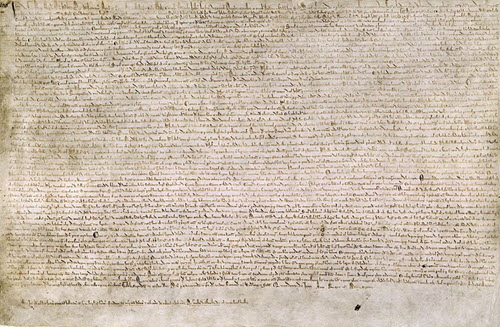This summer marks 800 years since King John affixed his royal seal to the Magna Carta at Runnymede, England. Celebrations are being held around the world to mark the anniversary, including events in Vancouver and Victoria. What is it all about?
(Video courtesy of Magna Carta Canada)
In the summer of 1215, King John of England was forced to negotiate with rebellious nobles and the Archbishop of Canterbury in an attempt to hold onto his throne. King John, like his predecessors, ruled the kingdom through executive orders as if he was above the law. The English nobility protested against the King’s arbitrary exercise of authority. A string of military defeats and the imposition of new taxes added to the grievances of the nobles, and they raised an army and marched on Windsor Castle.
The king met the nobles on neutral ground, in a field near Runnymede, in June 1215. The nobles presented the king with a list of demands, and after a week of negotiation, King John affixed his royal seal to the Magna Carta. However, the agreement was short lived. Ten weeks after it was issued, at the behest of King John, the Pope annulled it.
Although the Magna Carta was re-enacted in later versions, it would not have attained the significance it has today had it not been for another conflict between the English King and the nobles who wanted to constrain the King’s powers. This occurred at the start of the 17th century, when King James I tried to assert the absolute authority of the monarchy. Sir Edward Coke, a celebrated judge who served as Chief Justice from 1606 to 1616, is the person most responsible. In the Case of Proclamations and in Dr. Bonham’s Case, Coke held that because of the Magna Carta the King himself was subject to the law, and that the Court had a power of judicial review over legislation. In Coke’s hands, the Magna Carta became a means to legitimize judicial oversight of the King’s actions.
Since the 17th century, Sir Edward Coke’s interpretation of the meaning of the Magna Carta has animated numerous different Bills of Rights. Looking back in time, they include the Canadian Charter of Rights and Freedoms (1982), the United Nations’ Universal Declaration of Human Rights (1948), the US Bill of Rights (1791), and the French Declaration of the Rights of Man and of the Citizen (1789).
You can read the text of the Magna Carta, and find the passages that inspired those later Bills of Rights, like the guarantee in clause 39 that no one shall be punished “except by the lawful judgment of his peers or by the law of the land.”

Today, the Magna Carta has come to stand for much more than the King and nobles could have anticipated at Runnymede in 1215. It is seen by many as the bedrock of the rule of law. The British judge Lord Denning called it, “the greatest constitutional document of all times - the foundation of the freedom of the individual against the arbitrary authority of the despot.”
This article provides general information only and should not be used authority in court proceedings or as a substitute for legal advice.

